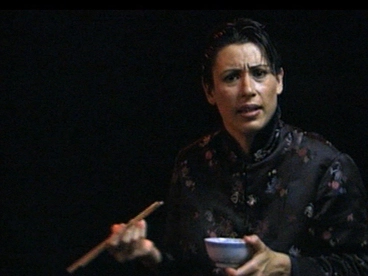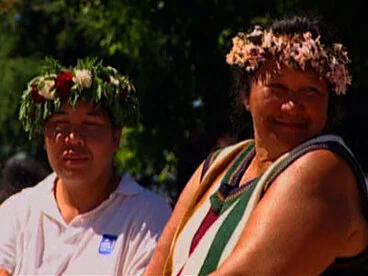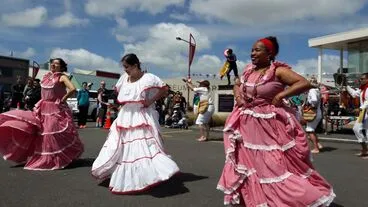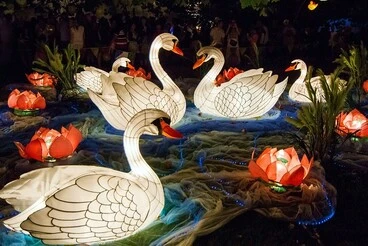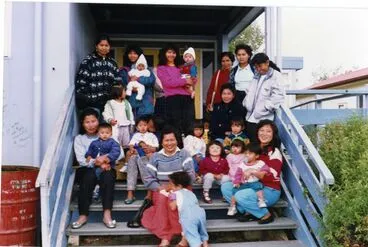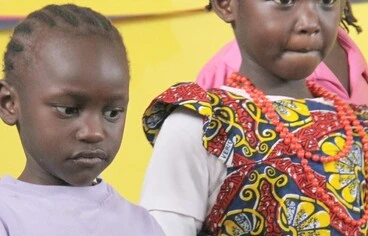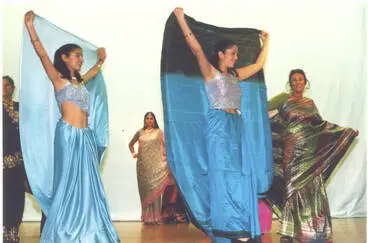Multiculturalism: Tuia Mātauranga Curiosity Card
A DigitalNZ Story by National Library Services to Schools
New Zealand's growing cultural diversity is reflected in the many multicultural events and festivals celebrating ethnic arts, food, performances religion and social activities.
14th Tauranga Multicultural Festival, Tauranga, New Zealand in 2013
Tauranga City Libraries
WHAKATAUKĪ
"Ma tini ma mano ka rapa te whai."
"By many, by thousands, the work (project) will be accomplished."
Multicultural manners
Manatū Taonga, the Ministry for Culture and Heritage
Chinks, Coconuts and Curry-munchers
NZ On Screen
BACKGROUND
Multicultural New Zealanders
New Zealand is a land of immigrants from other places. But at some point, a distinct character, the New Zealander, emerged.
New influences
From the 1950s onwards, New Zealanders’ view of themselves continued to change: The country began to break its ties with Britain. People in cities, including women, disliked the male, rugby-and-war image. Māori claimed that there were not one but two cultures. Immigrants from the Pacific and Asia brought new traditions. New Zealanders made their mark in new fields, from movies to fashion to scientific research.
Today there are many ideas about what it is to be a New Zealander.
Source: 'The New Zealanders', URL: http://www.teara.govt.nz/en/the-new-zealanders, (Ministry for Culture and Heritage), (updated 20-May-2015)
Hapori
He tini ngā tāngata o Aotearoa i whānau ki tāwāhi. Nā whai anō he whenua takenga maha a Aotearoa i tēnei te rau tau 2000. I ahu mai ngā manene i Āhia, Te Moananui-a-Kiwa, Ūropi, me kī, ngā pito katoa o te ao. Kua rerekē tēnei whenua mai i te wā ko te Māori me te Pākehā anake ngā tāngata. Heoi, he wāhi nui tonu kei ngā tikanga a te Māori me te Pākehā ki Aotearoa.
Source: 'Hapori', URL: http://www.teara.govt.nz/mi/hapori, (Ministry for Culture and Heritage), (published 8-February-2012)
The multicultural idea
Many of these people, from a wide range of cultures, settled down, took up citizenship and brought up New Zealand-born children. This was a major challenge to the idea of who New Zealanders were. Initiated in Canada and picked up in the 1970s in Australia, the concept of multiculturalism quickly spread to New Zealand. It was proposed that people could be legitimate members of the New Zealand nation while retaining their own language, foods and traditions. At the first New Zealand Day ceremony at Waitangi in 1974 there were ostentatious efforts to put New Zealand’s ethnic variety on display.
Challenge for a new century
At the beginning of the 21st century it was not easy to define the New Zealander, nor even to explain the origin of many New Zealand characteristics. The character of the country’s people had been in part shaped by the physical environment – the outdoor climate, the proximity to beach and bush, the location in the South Pacific. No less important were the very different cultures brought to the country by waves of settlers – Māori who arrived some 700 years ago from the Pacific, the British and Irish who dominated the population for over a century from 1850, and more recent immigrants from Asia and the Pacific. All of these groups would have agreed that each were New Zealanders. All would have accepted that New Zealanders were no longer ‘Better Britons’. But the cultural meaning of the New Zealander had become uncertain. How it would evolve was one of the major issues for the new
Source: 'The New Zealanders - Multicultural New Zealand', URL: http://www.teara.govt.nz/en/the-new-zealanders/page-13, (Ministry for Culture and Heritage), (updated 20-May-2015)
QUICK FACTS
- The 3 most important challenges faced by migrants when they first arrive in New Zealand are language and communication, employment, and the cost of living.
- Research shows that ethnic diversity at the leadership level is one key ingredient missing from a truly inclusive New Zealand multicultural society.
- New Zealand is amongst the most culturally and ethnically diverse nations in the world.
- The theme for 2019 Race Relations Day is Our people, our cultures, our languages, Ō tātou iwi, ō tātou ahurea, ō tātou reo.
- The Middle Eastern/Latin American/African, and Asian ethnic groups increased by more than 30 percent between the 2006 and the 2013 Censuses.
- Auckland is home to the largest Polynesian population of any city in the world.
- Auckland is also New Zealand’s most cosmopolitan city. Around 40% of the city's population was born overseas.
- It is estimated that the Māori population will make up nearly 20 per cent of the population in 2038, the Asian population will make up 21 per cent while the Pacific population will reach 11 percent of New Zealand’s population.
Burundian drumming and dancing
Manatū Taonga, the Ministry for Culture and Heritage
Ōtara Market
NZ On Screen
Sri Lankans at a multicultural festival
Manatū Taonga, the Ministry for Culture and Heritage
OTHER RESOURCES
Assist refugees — every year New Zealand welcomes refugees into our communities who have endured significant hardship.
figure.NZ — charts and tables about New Zealand’s ethnic groups.
Major ethnic groups in New Zealand — this infographic presents some key characteristics of New Zealand’s major ethnic groups in 2013.
Multicultural New Zealand — the New Zealand Federation of Multicultural Councils is a organisation for the ethnic communities of New Zealand.
National ethnic population projections — these releases provide a summary of the projected Māori, Pacific, Asian, and 'European or Other' ethnic populations of New Zealand.
New Zealanders value a strong multicultural society — New Zealanders value a strong multicultural society, with 89% agreeing that it is a good thing for society.
Our new society — despite being the last land mass to be inhabited by humans, we are now one of the most ethnically diverse.
The importance of diversity in NZ — imagine for a minute, a New Zealand without vineyards, wonton soup, Diwali or the art of John Pule.
Unlocking the benefits of ethnic diversity — Berlinda Chin calls herself an “involuntary migrant”.
Wairoa: New Zealand's most diverse spot — in Wairoa, 62.29 per cent of the population identify as Māori.
Kato tia hulu (basket)
Museum of New Zealand Te Papa Tongarewa
Pacific Island love dances
Manatū Taonga, the Ministry for Culture and Heritage
Latino Fiesta
Palmerston North City Library
Nepal Night - Tauranga Multicultural Council event 2008,15
Tauranga City Libraries
bag, prayer shawl
Auckland War Memorial Museum Tāmaki Paenga Hira
Beautiful Swan Lanterns
Manatū Taonga, the Ministry for Culture and Heritage
FERTILE QUESTIONS
- What can people from different cultures learn from each other?
- Ka ākona tātou ki te aha e ngā iwi nō ahurea kē?
- What are the benefits and challenges of a diverse society?
- He aha ngā mea i whāngai i te kōaro?
- How can we show respect to others?
- What is your question?
Cambodian refugees at Kelvin Grove Community Hall
Palmerston North City Library
European migrants: Polish refugees
Manatū Taonga, the Ministry for Culture and Heritage
World Refugee Day
Manatū Taonga, the Ministry for Culture and Heritage
ADDITIONAL QUESTIONS
- How are some aspects of culture not (easily) understood by those from another culture?
Ethiopian refugees reunited
Manatū Taonga, the Ministry for Culture and Heritage
Māngere Refugee Resettlement Centre
Manatū Taonga, the Ministry for Culture and Heritage
Refugees
DigitalNZ
Multicultural festival 2005.
Auckland Libraries
Multicultural festival, Auckland
Museum of New Zealand Te Papa Tongarewa
This story was curated and compiled by Te Puna Mātauranga o Aotearoa | National Library of New Zealand, Services to Schools staff, 2019.

